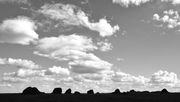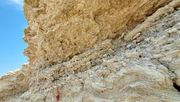Columbia Basin vs. Columbia Plateau
Controversy continues to swirl among geo-nerds as to whether to call the vast inland region located east of the Cascade Mountains the Columbia Basin or the Columbia Plateau. The terms are almost pure opposites: Basins are low. Plateaus are high. Controversy!
People on Twitter prefer the term "Plateau". Normal people prefer "Basin". Controversy!
Actually there is no controversy. A few dorks (like me) occasionally revive the topic and trundle out opposing arguments over beers around a campfire. Discussion ends with the first mention of Elon Musk. Nevertheless, the following article presents evidence supporting the use of each term. Spoiler alert: Basin wins.

The Columbia Basin/Plateau Region roughly corresponds to the brownish area in this map.
But first, some background. A few years ago, I was asked to contribute a short article on clastic dikes to a book on the natural history of the Walla Walla Valley. The editor accepted my submitted draft, but preferred that I use "Columbia Plateau" instead of "Columbia Basin" in order to maintain consistency across all articles in the book. I objected on grounds that "Basin" was just as legitimate a term as "Plateau". The region is topographically low and "Basin" was better suited to my article's discussion of valley sediments. The editor allowed me to retain "Basin", presumably to avoid a donnybrook outside the Editor's office.

J Harlan Bretz's "Channeled Scabland and the Associated Features on the Columbia Plateau in Washington", published by American Geographical Society in Geographical Review v. 18, 1928.

Bretz's (1932) map shows "Walla Walla Plateau", "Horseheaven Plateau", "Waterville Plateau", and "Uniontown Plateau".

The Columbia Basin appears on the map of Washington's physiographic divisions (WADNR, 2001) and on a previous version by Weissenborn (1978).
In Support of "Columbia Plateau"
In general, government, recreation, groundwater, and environmental organizations use the term Plateau.
The Columbia River Plateau is formed by the Columbia River Basalt Group which erupted during the late Miocene and early Pliocene.
Columbia Plateau Aquifer System, a multi-layered aquifer within the Columbia River Basalt that covers some 44,000 square miles.
Columbia Plateau Ecoregion is an arid sagebrush steppe and grasslands region encompassing some 32,000 square miles. The region is flanked by moister, predominantly forested, mountainous ecoregions on all sides.
Plateau Tribes refers to indigenous peoples of a vast inland region that approximately corresponds to the Columbia River and Fraser River watersheds.
Columbia Plateau Trail State Park is a 130 mile-long recreational path that runs along an abandoned railway.
According to Wikipedia: "Columbia Plateau is the geographic region in the Pacific Northwest commonly referred to as the Columbia Basin".
Columbia Plateau Pocket Mouse (Perognathus parvus) is a non-migratory, non-social rodent that occupies portions of the Great Basin. During winter it enters torpor and is not active.
Few businesses and organizations use Plateau in their names. One exception is Columbia Plateau, Inc., an elitist roofing company.

Promotional map of the Columbia Basin Project by the Columbia River Development League, 1925.
In Support of "Columbia Basin"
In tectonic parlance, the region is known as a back-arc basin and a structural depression (Campbell, 1989; Saltus, 1993).
The region is ringed by mountains: Cascades, Horse Heaven Hills, Blue Mountains, and Okanogan Highlands. Even more mountains can be found to the east, in Idaho.
Major rivers flow into the region, not around it. These include the Columbia, Snake, Yakima, Walla Walla, Umatilla, Tucannon, Methow, Spokane, Okanogan, and others. Ancestral versions of these rivers also flowed into the area over the past 20 million years. The region has remained a low spot since the Miocene.
Flood basalts fill low spots. The Columbia River Basalt accumulated here.
Sediments shed from surrounding uplands have accumulated here for millions of years. Up to 5km of Oligocene-Eocene age sedimentary rocks lie beneath the Columbia River Basalt and a few hundred meters of Neogene-Holocene age sediments lie on top (i.e., Ellensburg Fm, Ringold Fm).
The Missoula floods flowed into the region, excavating the Channeled Scabland and depositing their sediment loads here.
Three versions of Washington's Physiographic Divisions Map name the region Columbia Basin (Campbell, 1962; Weissenborn, 1978; WADNR, 2001) as does the "regions" map in Roadside Geology of Washington 2nd Edition (Miller and Cowan, 2017).
The USGS includes 'Columbia River Plateau Basins' in its catalog of sedimentary basins in the U.S. (Coleman and Cahan, 2012):
The Columbia River Plateau Basins is a collective term to include all of the sedimentary and volcanic-sedimentary basins within the Columbia River Plateau of northern Oregon and southern Washington. This grouping includes the Swauk, Yakima, Umatilla, Pasco, and Quincy Basins, plus several smaller basins. These basins are separated from each other by anticlinal folds. The boundary for this collective basin is interpreted from Cohee and others (1962) and King and Beikman (1974).
The Columbia Basin Irrigation Project is a U.S. Bureau of Reclamation-managed network of open canals and headworks that originate at Grand Coulee Dam. The project irrigates hundreds of farms in the region via gravity flow.
Washington Water Power Company's 1923 map of its Spokane Service Area calls it the Columbia Basin.

Everyone needs a Hotsy. They sell 'em in Pasco.
Columbia Basin College has an enrollment of >11,000 students and is located in trend-setting Pasco, WA.
The Columbia Basin Herald is a newspaper in Moses Lake, WA.
Basin City is a bustling, influential town in Eastern Washington. Plateau City is not found on any map, Bob.
Columbia Basin Hospital is located in Ephrata, WA.
My Grandpa, a decorated Navy pilot and life-long farmer out of Connell called it "The Basin".
The Columbia Basin Pygmy Rabbit (Brachylagus idahoensis) is a woefully maladapted rodent that serves no function other than scooby snack for nearly every predator in the region larger than your shoe. This pitiful stub-twig on the tree of rodent evolution will surely go extinct. Luckily, evolution has chosen Wegmann's Dust Bunny (broomless roommatensis) to fill its ecological niche.

Air National Guard memorial in Othello, WA
Basin Disposal is a trash hauling company out of - you guessed it - Pasco.
My favorite description of the region comes from WPA writers, "the Columbia Basin is both a land of promise and a graveyard of hope."
Smith et al. (1989) admit that "no single geomorphic term aptly describes the variety of structural and topographic features that are encompassed by the Columbia River Basalt Group. The long-used term "Columbia Plateau" is applied herein, with acknowledgment of its inadequacy."
A number of businesses and organizations use Basin in their name, including Columbia Basin Agricultural Research Center (OSU Extension Lab), Columbia Basin Hotsy (pressure washing), Columbia Basin Knot Company (rigging), Columbia Basin Badger Club (a crepuscular mustelid appreciation society), Columbia Basin Water Transactions Program (water-related NGO), Columbia Basin BMX (bike racing dudes), Columbia Basin Netwerks (web and IT), Columbia Basin Electric Co-Op (power company), Columbia Basin Development League (pro-irrigation NGO), and Columbia Basin Foundation (charitable giving).


A 1925 map by the Columbia Basin Irrigation League and Dyer Printing. For a time, the region was known as the "Empire within an Empire". The Grant County Economic Development League longs for return of the good 'ole days.
Ephrata is in the process of updating its current motto: "Like No Place in Idaho".
Motto options for Ephrata, WA:
"Gateway to the Beezley Hills"
"Like Moses Lake, but Really Effing Classy"
"Land of Promise, Graveyard of Hope"
"The Thorp of Grant County"
"Third Rate City, First Rate Baseball"
"Forever Irrigating Sand Dunes for the Betterment of Future Generations"
"Home of the 1895 Olympic Games"
"Not Pasco"
"Future Home of Roy's Western Smorgy"

The author of this 1882 map (T.W. Symons) was unwilling to commit one way or the other. He punts, calling the region "The Great Plain of the Columbia River". What a wimp.

Topographic profile from Cape Flattery to Asotin from Google Earth. Does that look like a plateau to you? Should we also start saying Puget Plateau? Its remarkable how little evidence there is for the name Plateau. Geography of the imagination.

Topography bats clean up.























